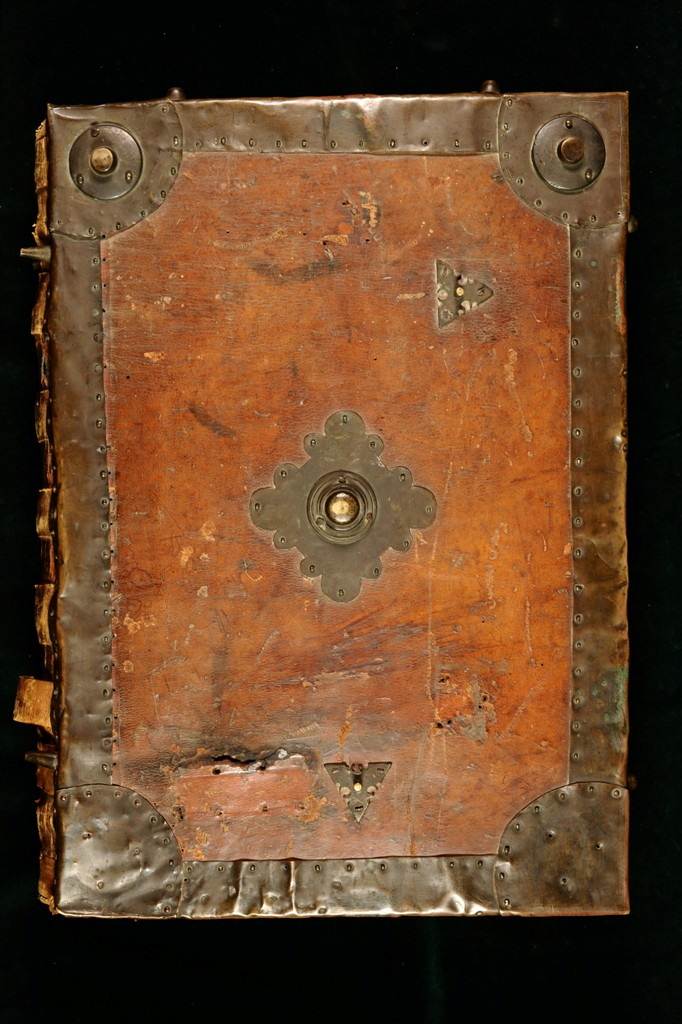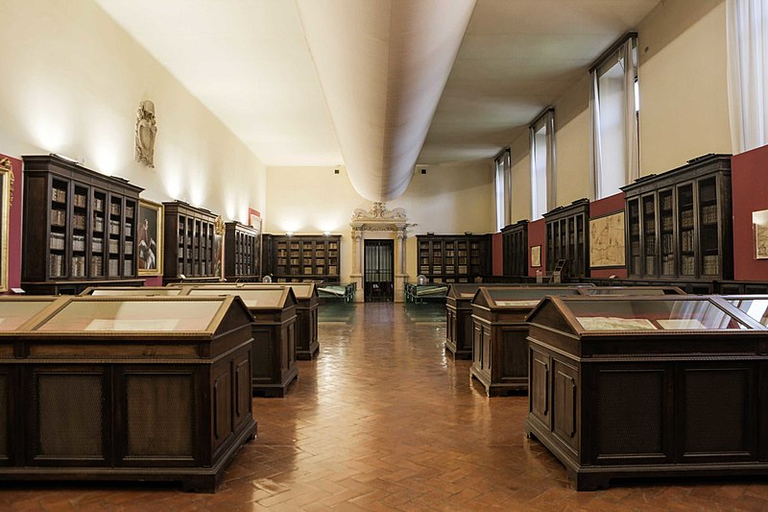
Create your photos and images as Slideshow for eBay, Netlog, MySpace, Facebook or your Homepage! Show all images of this Slideshow
The Malatesta Library of Cesena is a monastic library of particular historical importance.
Founded in the mid-15th century, it has two absolute firsts: it was the first public library in Italy and Europe, and it is the only example of a perfectly preserved medieval monastic library in terms of building, furnishings and books.

UNESCO has recognized the cultural importance of the Malatesta Library inserted earlier in Italy, in the Memory of the World Register, Il 19 settembre 2008.
The Italian Post has issued a stamp dedicated to the library, on the theme of the series ‘The Italian cultural and artistic heritage’.
Today, almost 250.000 volumes are preserved, among which 287 incunabula, about 4.000 cinquecentine, 1753 manuscripts from the XVI and the XIX century, and more than 17.000 letters and autographs.

One of the greatest losses in the last century in the cultural heritage of Cesena was undoubtedly the complex where the convent of San Francesco was located.
All that remains is the Malatesta Library, which is preserved in the same condition as it was originally (the building work began in 1250 and the convent was consecrated in 1290).
The architectural style.

The external appearance of the Malatesta Library was radically modified after the construction of the nineteenth-century buildings that replaced the main hall of the monastery.
Only from the Cloister of San Francesco and from the courtyard of Palazzo Ghini is it possible to see, respectively, the north side and the front of the nave of the library. The volume, whose materials are very simple, is built of exposed brick.
The front wall is decorated only with an opening in the form of a rose window, while the side walls are pierced by a series of small windows with pointed arches and a ceramic cornice.

Inside, after climbing the stairs to the first floor and passing through two corridors, one enters the vestibule that precedes the main hall, the ‘Aula del Nuti’. This hall separates it in turn from the adjacent Piana Library, which has a cane given by Pope Pius VI to his native city.
The Malatesta Collection

The Malatesta collection was the brainchild of a single patron, Novello Malatesta (1418-1465), and was built up in a short space of time.
The collection has an extensively systematic character (today we would say ‘encyclopaedic’) because it was not intended to satisfy Malatesta's personal interest but for the studies of a monastic community.
Domenico Malatesta declared his role as promoter by including on the first page of each code his coat of arms, richly ornamented in the ancient manner, and the initials ‘M’ and ‘N’ painted in gold or in other colours, inscribed in a gold rectangle.
Archaeological and artistic heritage.

In 1813, the librarian Giovanni Carli received from the mayor an ancient vase, found during road works: he decided to keep it in the Malatestiana, thus initiating a two-headed characterisation of library and ‘archaeological museum’.
In fact, the corridor on the first floor is dotted with the most varied finds, coming from the city but above all from the cloister of San Francesco: inserted in the walls, there are mainly tombstones, epigraphs, coats of arms, fragments of cornices and columns, plaques and epitaphs, referring to families, cardinals and citizens of Cesena. They date from the 14th to the 18th century and were only placed here during the 20th century.
In the room at the end and to the left of the first-floor corridor, at the right-hand turn, is the sculpture of St George slaying the dragon, sculpted in relief on a slab of Istrian stone measuring 1.63 m x 3.91 m. It is dated to around 1414.

It has been dated to around 1420: the larger central panel depicts the saint in the act of piercing the animal; the relief on the left consists of a helmet and a leopard, the relief on the right of a helmet with a crest in the shape of an elephant. On the basis of this precise iconography, it has been hypothesised that the slab is a monument celebrating the victory of the Malatesta family over the Visconti of Milan (who were indicated by a leopard) near Porta Vercellini.
For centuries it was kept in the keep of the castle of San Giorgio along with other sculptures; in 1820, with the progressive dismantling of the castle, it was moved to the town hall, passing from there to the library at an unspecified time.

Crea le tue foto ed immagini come Slideshow per eBay, Netlog, MySpace, Facebook o la tua Homepage!Mostrare tutte le immagini di questo Slideshow
La Biblioteca de Malatesta de Cesena es una biblioteca monástica de importancia histórica particular.
Fundada en el siglo XV a mediados, tiene dos primicias absolutas: fue la primera biblioteca pública d 'Italia y de Europa , y es el único ejemplo de una biblioteca monástica medieval perfectamente conservado en el edificio, mobiliario y libros.

La UNESCO ha reconocido la importancia cultural de la Biblioteca Malatestiana inserta antes en Italia, en el Registro de la Memoria del Mundo, Il 19 settembre 2008 .
El correo italiano ha emitido un sello dedicado a la biblioteca, sobre el tema de la serie "El patrimonio cultural y artístico italiano".
Hoy en día, se conservan casi 250.000 volúmenes, entre ellos 287 incunables, unos 4.000 cinquecentine, 1753 manuscritos desde el siglo XVI y el siglo decimonoveno, y más de 17.000 cartas y autógrafos.

Una de las pèrdidas màs grandes en el siglo pasado en el patrimonio cultural de Cesena ha sido sin lugar a dudas el complejo donde se encontraba el convento de San Francisco.
Ha quedado solamente la Biblioteca Malatestiana que se conserva en la mismas condiciones que tuvo originariamente (los trabajos de construcciòn iniciaron en el año 1250 y el convento fue consagrado en el año 1290).
El estilo arquitectónico.

El aspecto exterior de la Biblioteca Malatestiana fue modificado radicalmente tras la construcción de los edificios decimonónicos que sustituyeron la sala principal del monasterio.
Sólo desde el Claustro de San Francisco y desde el patio del Palacio Ghini es posible observar, respectivamente, el lado norte y el testero de la nave de la biblioteca. El volumen, de gran sencillez en sus materiales, está construido en ladrillo visto.
El testero está ornamentado únicamente con una abertura en forma de rosetón, mientras que los muros laterales están perforados por una serie de pequeñas ventanas de arco apuntado y una cornisa de cerámica.

En el interior, después de subir las escaleras que llevan a la primera planta, y de atravesar dos pasillos, se accede al vestíbulo que precede a la sala principal, el “Aula del Nuti”. Este vestíbulo la separa a su vez de la adyacente Biblioteca Piana, que cuenta con un bastón cedido por el papa Pío VI a su ciudad natal.
La Colección Malatestiana.

La colección malatestiana surge por el deseo de un único mecenas, Novello Malatesta (1418-1465), y fue realizada en poco tiempo.
La colección tiene un carácter extensamente sistemático (hoy diríamos "enciclopédico") porque no estaba dirigida a satisfacer el interés personal de Malatesta sino a los estudios de una comunidad monástica.
Domenico Malatesta declaró su papel de promotor haciendo incluir en la primera página de cada código su escudo, ricamente ornamentado a la manera antigua, y las iniciales "M" y "N" pintadas en oro o en otros colores, inscritas en un rectángulo de oro.
Patrimonio arqueológico y artístico.

En 1813, el bibliotecario Giovanni Carli recibió del alcalde un antiguo jarrón, encontrado durante unas obras viales: decidió conservarlo en la Malatestiana, iniciando una caracterización bicéfala de biblioteca y "museo arqueológico".
De hecho, el pasillo del primer piso está salpicado de los más variados hallazgos, procedentes de la ciudad pero sobre todo del claustro de San Francisco: insertados en las paredes, se encuentran principalmente lápidas, epígrafes, escudos, fragmentos de cornisas y columnas, placas y epitafios, refiriéndose a familias, cardenales y ciudadanos de Cesena. Datan de entre los siglos XIV y XVIII y solo se colocaron aquí durante el siglo XX.
En la sala al final y a la izquierda del pasillo del primer piso, en el giro a la derecha, se exhibe la escultura San Jorge matando al dragón, esculpida en relieve sobre una losa de piedra de Istria de 1,63 × 3,91 metros.

Se ha fechado alrededor de 1420: el panel central, más grande, representa al santo en el acto de perforar al animal; el relieve de la izquierda se compone de un casco y un leopardo, el de la derecha de un casco con cresta en forma de elefante. A partir de esta iconografía precisa, se ha planteado la hipótesis de que la losa es un monumento que celebra la victoria de los Malatesta sobre los Visconti de Milán (que se indicaban con un leopardo) cerca de Porta Vercellini.
Durante siglos se conservó en la torre del homenaje del castillo de San Giorgio junto con otras esculturas; en 1820, con el progresivo desmantelamiento del castillo, se trasladó al ayuntamiento, pasando de allí a la biblioteca en un momento no especificado.

Source images / Fuente imágenes: Biblioteca Maltestiana.


